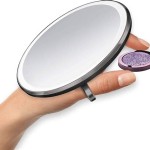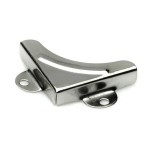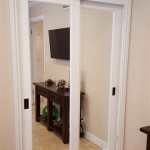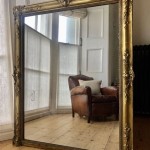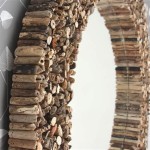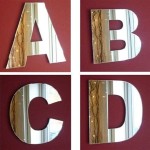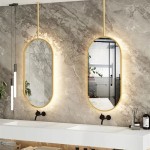Decorative Mirrors for Dining Room Walls and Ceilings: Enhancing Space and Style
Mirrors, beyond their functional purpose, offer a significant design element capable of transforming the ambiance of any room. In the dining room, decorative mirrors can amplify light, create the illusion of spaciousness, and introduce an element of sophistication. The strategic placement of mirrors on walls and even ceilings can dramatically alter the perception of the room, turning a simple dining area into a visually stunning and inviting space.
Selecting the right mirror, or combination of mirrors, for a dining room requires careful consideration of several factors. These factors include the room's existing décor, the desired aesthetic, the amount of natural light available, and the architectural features of the space. This article will explore various ideas for using decorative mirrors on dining room walls and ceilings, providing insights into how to effectively leverage their visual potential.
Expanding Space with Strategic Mirror Placement
One of the most compelling reasons to incorporate mirrors into a dining room design is their ability to create the illusion of a larger space. This is particularly beneficial in smaller dining rooms or areas that feel cramped. By strategically positioning mirrors, it is possible to visually expand the room's dimensions, making it feel more open and airy.
A large mirror placed on a wall opposite a window can effectively double the amount of natural light that enters the room. This is because the mirror reflects the light streaming in from the window, distributing it more evenly throughout the space. The reflective surface also creates the illusion of a window where none exists, adding depth and dimension to the room. The larger the mirror, the more significant the effect will be.
Another technique involves using a series of smaller mirrors to create a gallery wall effect. These mirrors can be of varying shapes and sizes, arranged in a visually appealing pattern. This approach not only adds visual interest but also subtly expands the perceived size of the room. The reflections from multiple mirrors create a sense of movement and energy, preventing the space from feeling static.
For narrow dining rooms, a long, horizontal mirror placed along one of the longer walls can effectively widen the space. This creates a more balanced and proportional feel. The mirror should ideally extend the majority of the wall's length to maximize the effect. The placement should also take into consideration the reflections it will generate, avoiding the creation of distracting or unflattering images.
Mirrored panels, either as individual sections or integrated into a larger wall treatment, offer a more subtle way to expand the space. These panels can be framed or frameless, and can be arranged in various configurations to create different visual effects. They can also be tinted or antiqued to add a touch of character and sophistication. Mirrored panels are particularly effective when used in conjunction with other design elements, such as wainscoting or wallpaper.
Enhancing Décor with Mirror Styles and Finishes
Mirrors are not merely functional objects; they are also decorative elements that can significantly contribute to the overall aesthetic of a dining room. The style and finish of the mirror should complement the existing décor, enhancing the room’s character and creating a cohesive visual harmony.
For a traditional dining room, ornate mirrors with elaborate frames can add a touch of elegance and sophistication. These frames can be made of wood, metal, or resin, and can be adorned with intricate carvings or moldings. Gilt or antique finishes can further enhance the traditional aesthetic. The size and shape of the mirror should be proportionate to the size of the dining table and the overall scale of the room. A large, oval mirror above a sideboard or console table can create a focal point and add a sense of grandeur.
In a modern or contemporary dining room, sleek and minimalist mirrors with clean lines and simple frames are a better choice. Frameless mirrors or mirrors with thin metal frames can create a streamlined and understated look. Geometric shapes, such as squares, rectangles, or circles, are often favored in contemporary designs. The emphasis should be on simplicity and functionality, with the mirror serving to enhance the space without overwhelming it.
For a rustic or farmhouse-style dining room, mirrors with weathered wood frames or distressed finishes can add a touch of charm and character. These mirrors often have a more informal and relaxed feel, complementing the natural and organic elements of the rustic aesthetic. Repurposed materials, such as old barn wood or pallet wood, can be used to create unique and eye-catching mirror frames. The mirror can be paired with other rustic elements, such as exposed brick or reclaimed wood furniture, to create a cohesive and inviting space.
Tinted or antiqued mirrors can add a touch of vintage glamour to any dining room. These mirrors have a subtle, aged appearance that creates a sense of history and character. The tint can be a soft bronze, gold, or silver, adding warmth and depth to the room. Antiqued mirrors can be used to create a focal point above a fireplace or sideboard, or they can be incorporated into a mirrored wall treatment. The key is to use them sparingly, as too much antiqued mirror can make the room feel dark and dated.
Mirrors with decorative inlays or embellishments can also add a unique touch to a dining room. These mirrors may feature glass mosaics, metal accents, or other decorative elements that complement the room's overall style. The inlays can be subtle and understated, or they can be bold and dramatic, depending on the desired effect. The choice of embellishments should be carefully considered to ensure that they complement the existing décor and do not clash with other design elements.
Illuminating the Dining Room with Mirrored Ceilings and Reflective Surfaces
While mirrors are commonly used on walls, incorporating them into ceilings can create a dramatic and luxurious effect, maximizing light and adding a sense of height to the room. Furthermore, strategic placement of reflective surfaces throughout the dining room can amplify the impact of mirrors, creating a brighter and more visually dynamic space.
A mirrored ceiling can significantly enhance the sense of space and light in a dining room, particularly in rooms with low ceilings. The mirror reflects the light from the walls and furnishings, creating the illusion of a much taller space. It also adds a touch of glamour and sophistication, transforming the room into a truly special occasion space.
There are several ways to incorporate mirrors into a dining room ceiling. One option is to install a full mirrored ceiling, covering the entire surface with reflective material. This creates a dramatic and impactful effect, but it is important to consider the potential for glare and reflections. Another option is to use mirrored tiles or panels, arranged in a decorative pattern. This allows for more control over the amount of reflection and creates a more visually interesting ceiling treatment.
The type of mirror used for the ceiling is also an important consideration. Clear mirrors will provide the most reflection, while tinted or antiqued mirrors will create a more subtle and diffused effect. It is also important to ensure that the mirrors are properly installed and securely mounted to the ceiling to prevent any safety hazards.
Beyond mirrored ceilings, other reflective surfaces can be used to enhance the impact of mirrors in the dining room. Glass-topped tables, metallic accents, and polished surfaces can all contribute to a brighter and more visually dynamic space. A glass-topped dining table, for example, will reflect light from above, creating a sense of openness and airiness. Metallic accents, such as silver or gold candlesticks, vases, or picture frames, can add a touch of glamour and reflect light from surrounding sources. Polished surfaces, such as lacquered furniture or high-gloss paint, can also contribute to the overall reflective quality of the room.
Chandeliers with crystal embellishments are particularly effective at maximizing the impact of mirrors and reflective surfaces. The crystals refract light, creating a dazzling display of colors and patterns that are amplified by the mirrors. The chandelier should be positioned in a location where its light will be reflected by the mirrors, creating a focal point and adding a sense of drama to the room.
The interplay of light and reflection is crucial to creating a successful and visually appealing dining room design. By carefully considering the placement of mirrors and reflective surfaces, it is possible to transform the room into a brighter, more spacious, and more inviting space. The key is to experiment with different ideas and techniques to find the combination that best suits the room's size, shape, and overall aesthetic.
:strip_icc()/dining-room-mirror-ideas-1-ashley-montgomery-b90b98cab74443e9ab4f9d5e9f6ac2d2.jpeg?strip=all)
17 Dining Room Mirror Ideas That Ll Dress Up Your Walls

The Best Dining Room Mirror Ideas Zhush

The Best Dining Room Mirror Ideas Zhush

Transform Your Dining Room With A Mirror Modern Interior Design Ideas Home Décor Inspiration Decoholic

Decorating Walls With Mirrors Professional Tips To Know Modern Interior Design Ideas Home Décor Inspiration Decoholic

Decorating With Mirrors In Some Stunning Ways World Inside Pictures

Designer Mirror Ideas For Living Rooms Reflecting Elegance

How To Decorate With Mirrors The Home Depot

5 Dining Room Mirrors A Must Have For Every Home

Small Dining Room Mirror Ideas To Make A Big Impact Ideal Home
